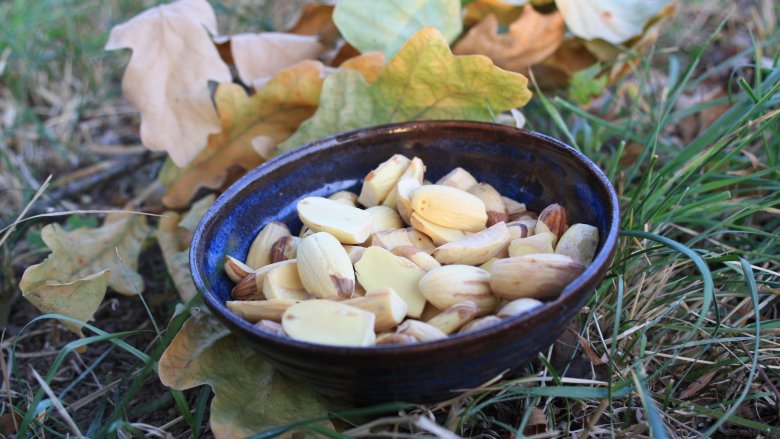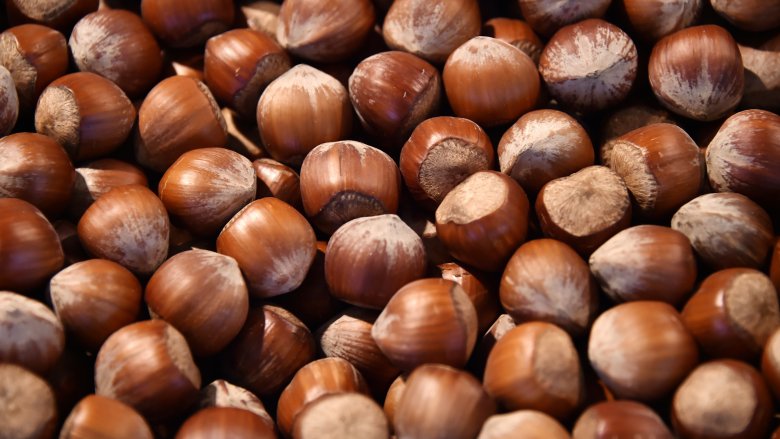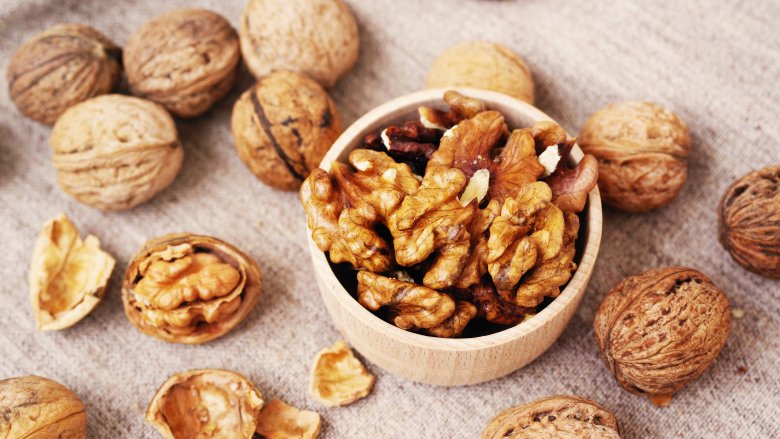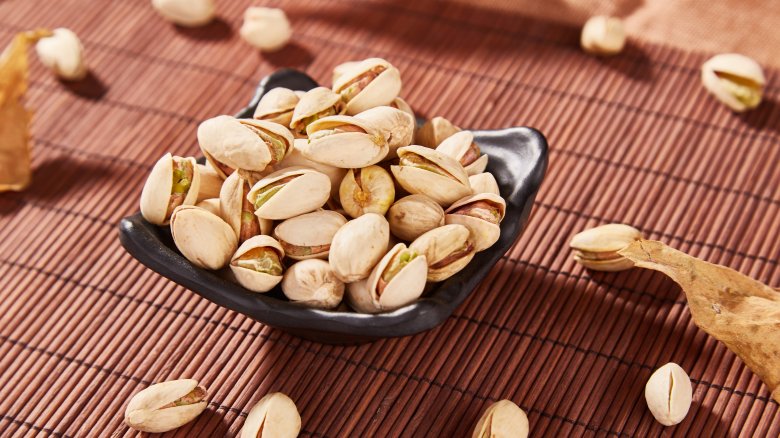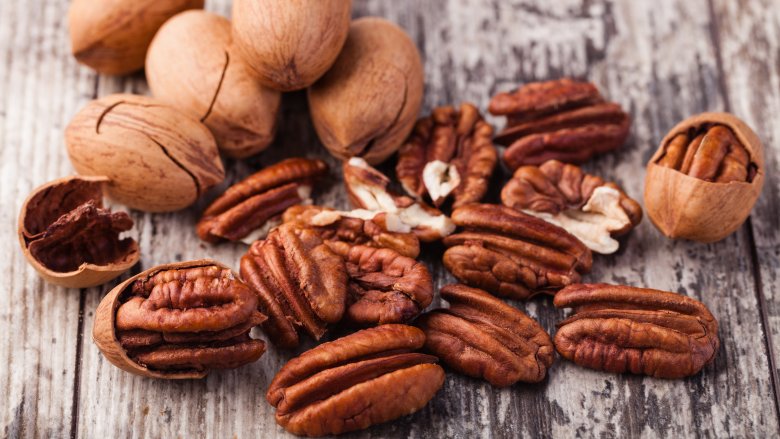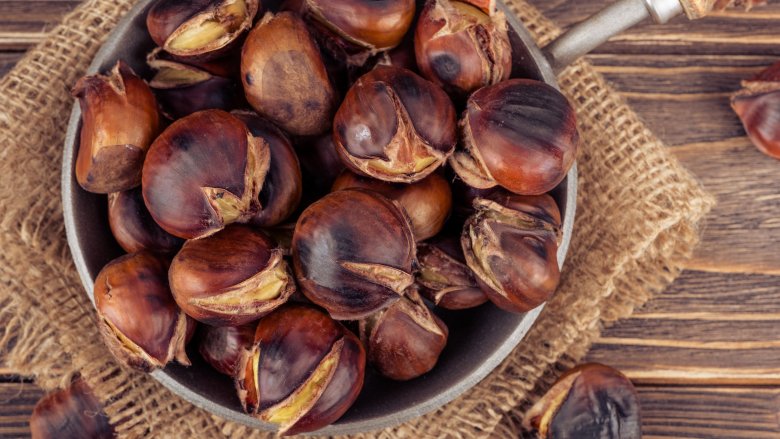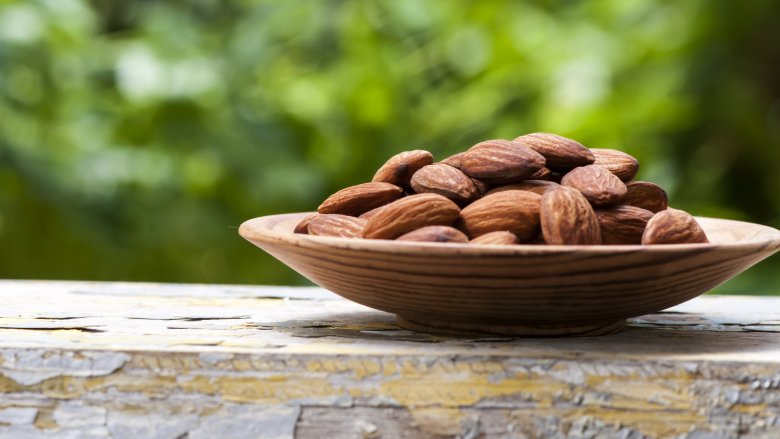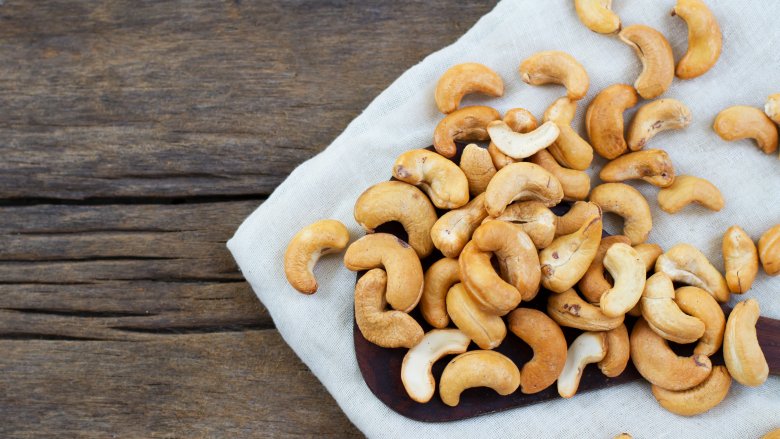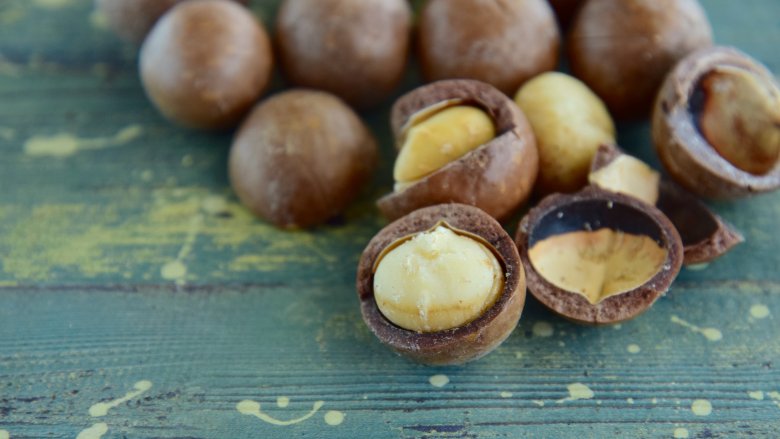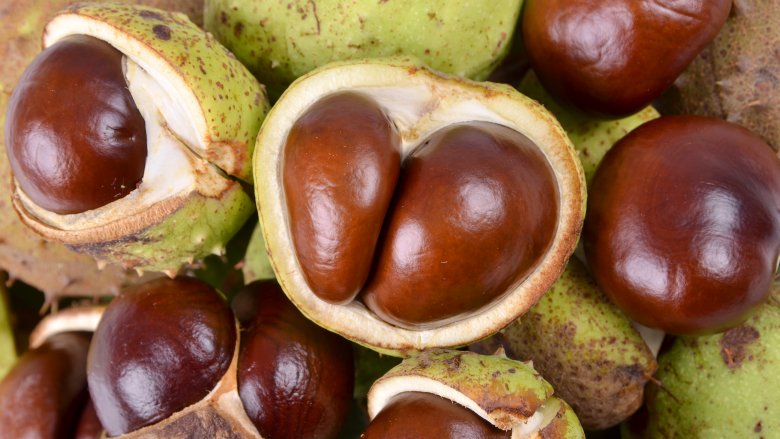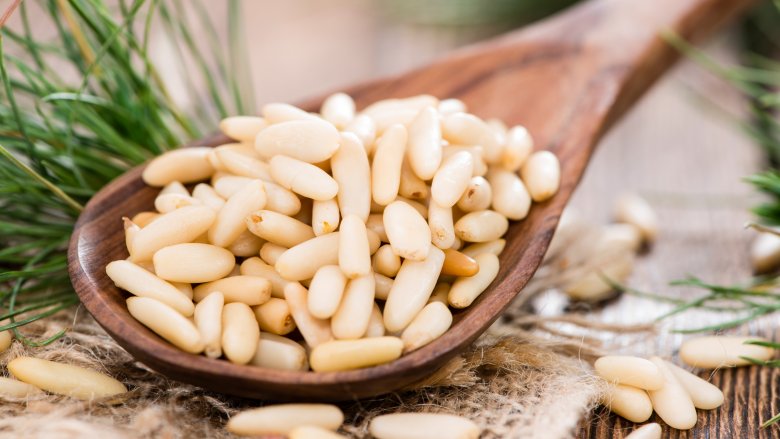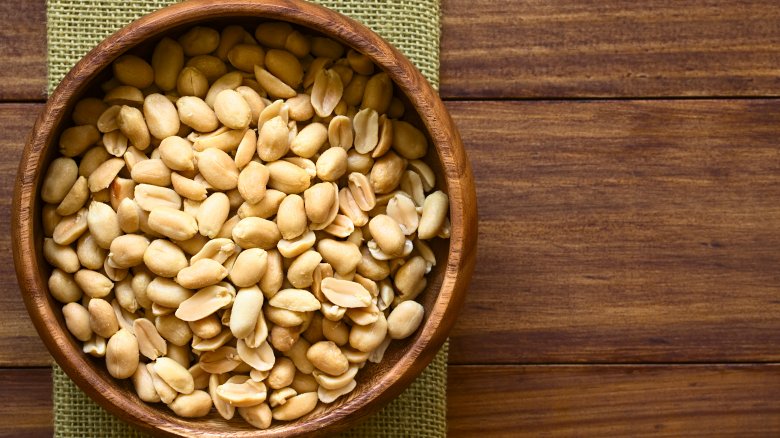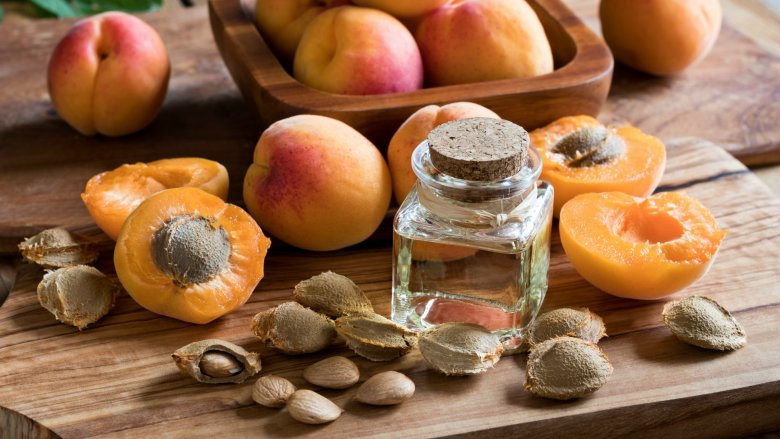7 Nuts You Should Be Eating And 7 You Shouldn't
If you're looking for a healthy snack, nuts might seem like a sure-fire win. But there are ways to go very, very wrong with picking up some nuts, so let's take a look at some that are both good for you and good for the environment, some that might ruin all of your best intentions, and some that might even make you sick.
Do eat: Acorns
You probably weren't expecting to be told to eat acorns, but you absolutely should! Humankind has been doing it for centuries, with references to eating acorns even scattered throughout Greek literature. Preparing them can be tough, though — you need to remove the meat from the shells and then soak them to remove the bitter and toxic tannins — and in our modern, convenient world, that can be a pain.
They're totally worth it, though, especially if you're concerned about helping to find and use a sustainable, widely available resource. Acorns are edible once they turn brown, and they're full of good things like proteins, healthy fats, and nutrients like vitamin C, calcium, and phosphorus. They've also been shown to help balance blood-glucose levels, and they have a ton of practical benefits. Acorns are widely available, easy to gather, and when they're dried and stored right, they can last for years. So, how can you use them? Check out this step-by-step guide from Learning and Yearning for making your own acorn flour, and you can turn that into breads and cookies that will have a wonderful, nutty flavor.
Do eat: Hazelnuts
If you love nothing more than hazelnut-filled cookies, you're in luck. They're incredibly good for you, as they're filled with things like vitamins A and B. Hazelnuts have a healthy dose of dietary fiber, and they also help raise good cholesterol while lowering the bad. You're not just doing yourself a favor when you help yourself to a handful, you're helping the environment, too.
Hazelnuts are a great example of sustainable agriculture. Not only do they require little water and minimal upkeep, but they can thrive in harsh soils where other plants would fail. They're drought-resistant, can survive harsh weather conditions, have a high yield per plant, and help prevent soil erosion. They also have massive root system, and they remove a huge amount of carbon from the atmosphere. It's a good thing they're so tasty, and even if you already have your favorite ways to use them, you'll still have to try this dairy-free dark chocolate and hazelnut spread from Beach Body on Demand, and this chocolate hazelnut fudge from Texanerin. Being environmentally friendly never tasted so good!
Do eat: Walnuts
Walnuts are one of those treats you might only think about during the holidays, and that's a shame. They're full of some amazing stuff, starting with a ton of vitamin E, and healthy fats. Not only do those things all help maintain good heart health, but some studies suggest adding them to your regular diet can lower your risk of a heart attack by as much as 51 percent. A healthy helping of walnuts will also help you ward off depression — they contain omega 3 oils that are shown to raise serotonin levels in the brain.
Walnuts also have a huge amount of antioxidants, more than what you'd get from any other nut. Antioxidants are key to maintaining good health, shown to help in the fight against heart disease, cancer, and the effects of premature aging. They even help keep us healthy on a cellular level, and even though walnuts are fairly high in calories (one ounce is about 180 calories), they come with so many other benefits that you should definitely sprinkle some on your salads. You can also make them a part of a healthy breakfast, with this banana walnut overnight oatmeal from Skinny Ms.
Do eat: Pistachios
Humankind has been eating pistachios since the dawn of our days, and there's a good reason for that: There's a lot of nutrition folded into this little package. They're high in protein and fiber, and a single ounce will give you the same amount of potassium you'd get from a banana. They've been linked to helping manage cholesterol levels and blood glucose levels, and adding them to your diet helps lower your risk of developing type 2 diabetes.
There's also some pretty awesome research that's been done with pistachios and their impact on weight management. A single serving of pistachios is 160 calories, but that serving is a whopping 49 nuts. Not only does that give you some bang for your snacking buck, but the act of shelling pistachios slows down your snacking speed and allows you to become more aware of how full you are, instead of falling into the mindless snacking trap. While you can definitely get your daily helping of pistachios that way, why not try this basil and pistachio pesto from Greedy Gourmet. It's easy to make and even easier to snack on.
Do eat: Pecans
Pecans are another nut that's vastly underused, mostly seeming to pop up in pecan pies. While that might not be a very healthy dessert, pecans are full of good stuff. They're loaded with antioxidants that help protect your heart and healthy fats that help lower your cholesterol. Studies have suggested that pecans can help manage weight, and they also have a type of antioxidant — vitamin E — that helps prevent age-related motor neuron degeneration as well as protect against cell damage and other degenerative diseases.
Adding pecans to a regular diet is especially important for men, because they contain something called beta-sitosterol. Not only does this help lower cholesterol levels, but it's been proven to be instrumental in maintaining prostate health. Two ounces of pecans a day has been shown to have a positive effect in managing and preventing an age-related condition called benign prostatic hyperplasia, or enlarged prostate. Fortunately, getting those two ounces a day is easy when you experiment with recipes like this pecan honey butter from Sparkles to Sprinkles or these chocolate caramel pecan turtles from Lil' Luna.
Do eat: Chestnuts
Chestnuts are usually associated with wintertime and the holidays, but they're something you definitely need to look into keeping around all year. Unlike other nuts, they're very low in fat and calories, but still have no cholesterol and plenty of protein, dietary fiber, and vitamin E. They're also one of only nuts that has a measurable amount of vitamin C, but there's something of a catch. They're more perishable than most nuts, and need to be kept in the fridge. Start using them regularly and they won't be around long enough to go bad, especially when you start using them as a low-calorie, low-fat companion to rice and pasta.
So, how exactly do you use them? Sure, you can roast them, but they also make a great addition to hearty comfort foods, like this mushroom, chestnut and ale pie from Wallflower Kitchen, and these chestnut and pear raviolis from Our Italian Table.
Don't eat: Almonds
Almonds are one of the most popular nuts, and that's not a surprise. Not only are they tasty but they're good for you, too. Boasting not just the ability to manage weight and prevent diabetes, they're touted as being a source of non-dairy milks for those who avoid dairy for a number of reasons. But all that goodness comes at a price, and if you're trying to be environmentally-friendly with your choices, you might want stop eating almonds.
The only US state that produces almonds commercially is California, and they're not just sending almonds to domestic markets. More than 80 percent of the world's almonds come from California, and it's a multi-billion dollar industry. California also has relentless problems with drought. You've heard the horror stories of water shortages and wildfires — now consider that every single almond you eat took 1.1 gallons of water to grow. The growing almond industry has had something of a domino effect, impacting even the populations of salmon that are plagued by low water levels. And that might not be worth it.
Don't eat: Cashews
Cashews are hugely popular nuts, and they're filled with things like fiber, protein, and all the standard good stuff that comes with nuts. But cashews come at a price, and it's paid by the people who harvest them.
The majority of cashews come from India and Vietnam, and picking them isn't an easy process. Cashew apples have several tough layers that need to be discarded, and those layers are toxic. Workers earn a pittance for shucking cashews, and many of them have suffered permanent damage from the toxic liquid that the shells release. An expose by Time magazine uncovered Vietnamese cashews are often the product of forced labor camps staffed by people addicted to drugs, and they coined the term "blood cashews." No matter how much you love the taste of cashews, is it worth that?
Don't eat: Macadamia
Macadamia nuts are delicious, but they're not as healthy as you might think. That's because a one-cup serving of macadamia nuts contains almost 1,000 calories, and it's incredibly easy to eat half your daily calorie allowance while you're munching. That same serving also has 102 grams of fat, which is more than you should get in a whole day.
Don't eat: Horse chestnuts
Chestnuts are one of the nuts you need to eat more of, but you should never, ever eat horse chestnuts. They look similar — both are the same color brown, and both have a lighter brown spot — but horse chestnuts are completely smooth. The good kind of chestnuts have a little point, and the difference is crucial.
In spite of how similar they look, horse chestnuts and chestnuts aren't actually related. Every part of the horse chestnut has a toxin that causes vomiting and, in large enough doses, paralysis. While you might hear that you can leach the toxins out of the horse chestnut, you shouldn't — and if you're in doubt, don't eat them. If you find some nuts on the ground, it's likely to be a horse chestnut, as they're toxic to animals, too.
Don't eat: Pine nuts
Pine nuts might be just the finishing touch a recipe calls for, but there's a weird and completely unexplained thing that can happen when you eat them. It's called pine mouth or pine nut syndrome, and it's a temporary thing that usually develops somewhere between 12 and 48 hours after eating the nuts. For a time, everything else will taste bitter, metallic, or rancid, and some people have had the taste last for months.
For most, it subsides after a few days to a couple weeks. The FDA has issued an alert, but there's been no confirmation as to what causes it and how to prevent it. It happens in people who don't have an allergy or sensitivity to nuts, eating something sugary makes the bitterness even worse, it's not connected to mold or bacteria, and it's happened with pine nuts from all different sources. It's completely unpredictable, so that means if you have a special dinner coming up, you might want to be extra careful about skipping the pine nuts.
Don't eat: Peanuts
Peanuts are a common enough snack, but there are a few things you should be aware of. While a serving will give you some valuable vitamins and nutrients, that same serving size is only 1.5 ounces, and it's going to account for a big chunk of your daily calorie intake. If you're sitting on the couch and munching peanuts while you're watching television, that's going to add up fast — just half a cup is a fifth of your calories for the day!
Peanuts are also associated with something called aflatoxins — they're not the only food that can be contaminated, and corn is also particularly vulnerable. Aflatoxins are a fungi, and entire crops can be contaminated at any time, from the field to storage after processing. Since they've been linked to an increase in the risk of liver cancer, it's vitally important to make sure you don't eat any peanuts that look moldy or discolored. Purchasing peanuts only from large-scale, well-known commercial companies will reduce the risk, but you still should use a lot of caution if you can't give them up.
Don't eat: Bitter almonds
Almonds might be delicious, but bitter almonds can be deadly. The kind we eat by the handful are sweet almonds, but bitter almonds are actually apricot kernels. Even though they're what gives that almond flavor to things like marzipan, eating them raw is dangerous. Raw bitter almonds are filled with a type of cyanide, and when they're prepared properly, they're cyanide-free and used as spices or flavorings.
They contain something called hydrocyanic acid, and that acid disappears when it's heated. But case studies of people who eat them raw are nothing short of terrifying, including one case where a 67-year-old woman ate only four (or five) bitter almonds, thinking they were "medicinal." Just that amount gave her light-headedness and nausea, and when she had 12 more, she was incapacitated and on her way to the emergency room within 15 minutes. Bitter almonds are nothing to mess around with, and should just be avoided.
